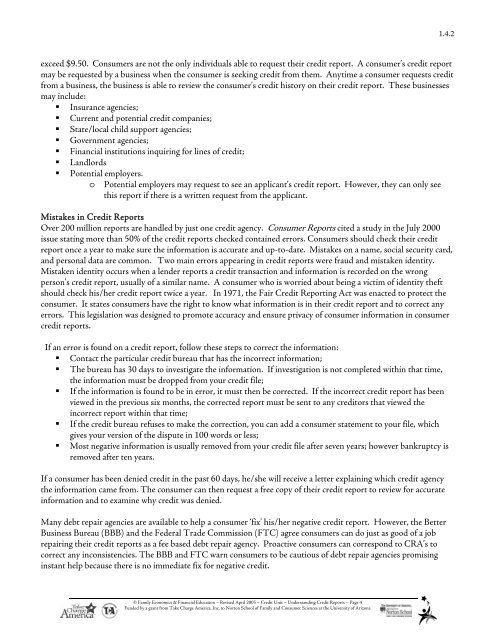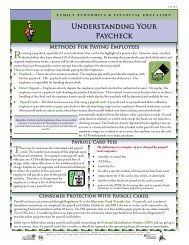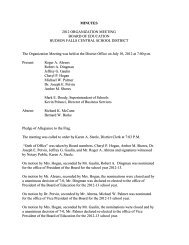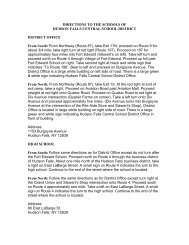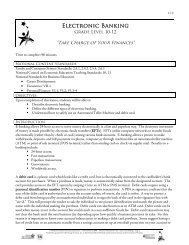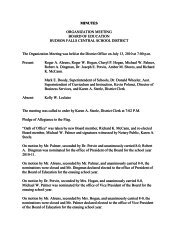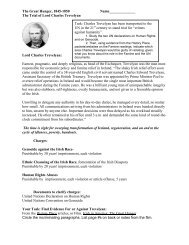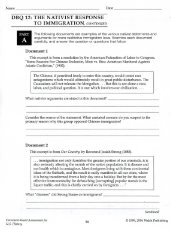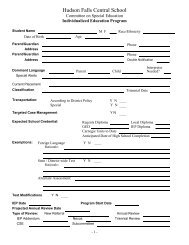You also want an ePaper? Increase the reach of your titles
YUMPU automatically turns print PDFs into web optimized ePapers that Google loves.
1.4.2exceed $9.50. Consumers are not the only individuals able to request their credit report. A consumer’s credit reportmay be requested by a business when the consumer is seeking credit from them. Anytime a consumer requests creditfrom a business, the business is able to review the consumer’s credit history on their credit report. These businessesmay include:• Insurance agencies;• Current and potential credit companies;• State/local child support agencies;• Government agencies;• Financial institutions inquiring for lines of credit;• Landlords• Potential employers.o Potential employers may request to see an applicant’s credit report. However, they can only seethis report if there is a written request from the applicant.Mistakes in <strong>Credit</strong> <strong>Reports</strong>Over 200 million reports are handled by just one credit agency. Consumer <strong>Reports</strong> cited a study in the July 2000issue stating more than 50% of the credit reports checked contained errors. Consumers should check their creditreport once a year to make sure the information is accurate and up-to-date. Mistakes on a name, social security card,and personal data are common. Two main errors appearing in credit reports were fraud and mistaken identity.Mistaken identity occurs when a lender reports a credit transaction and information is recorded on the wrongperson’s credit report, usually of a similar name. A consumer who is worried about being a victim of identity theftshould check his/her credit report twice a year. In 1971, the Fair <strong>Credit</strong> Reporting Act was enacted to protect theconsumer. It states consumers have the right to know what information is in their credit report and to correct anyerrors. This legislation was designed to promote accuracy and ensure privacy of consumer information in consumercredit reports.If an error is found on a credit report, follow these steps to correct the information:• Contact the particular credit bureau that has the incorrect information;• The bureau has 30 days to investigate the information. If investigation is not completed within that time,the information must be dropped from your credit file;• If the information is found to be in error, it must then be corrected. If the incorrect credit report has beenviewed in the previous six months, the corrected report must be sent to any creditors that viewed theincorrect report within that time;• If the credit bureau refuses to make the correction, you can add a consumer statement to your file, whichgives your version of the dispute in 100 words or less;• Most negative information is usually removed from your credit file after seven years; however bankruptcy isremoved after ten years.If a consumer has been denied credit in the past 60 days, he/she will receive a letter explaining which credit agencythe information came from. The consumer can then request a free copy of their credit report to review for accurateinformation and to examine why credit was denied.Many debt repair agencies are available to help a consumer ‘fix’ his/her negative credit report. However, the BetterBusiness Bureau (BBB) and the Federal Trade Commission (FTC) agree consumers can do just as good of a jobrepairing their credit reports as a fee based debt repair agency. Proactive consumers can correspond to CRA’s tocorrect any inconsistencies. The BBB and FTC warn consumers to be cautious of debt repair agencies promisinginstant help because there is no immediate fix for negative credit.© Family Economics & Financial Education – Revised April 2005 – <strong>Credit</strong> Unit – <strong>Understanding</strong> <strong>Credit</strong> <strong>Reports</strong> – Page 4Funded by a grant from Take Charge America, Inc. to Norton School of Family and Consumer Sciences at the University of Arizona


